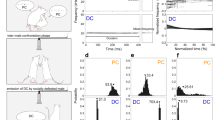Abstract
The influences of thermal and tactile stimuli on the audible vocalization in pup rats,Rattus norvegicus were investigated. Mother rats and their litters were exposed to ambient temperature (AT) depression by 5°C for 2 hours every other day from 3 to 11 days postpartum. Nearly all audible calls emitted by pups were recorded during tactile contact with the mother. AT depression alone neither prolonged the total duration of pup-licking by mother nor intensified audible vocalization. It was found, however, that the frequency (No./h.) of nest exiting by the dam doubled during the cooling and that the sum of audible peeps emitted by cooled pups in 4 cooling days was higher than sum of peeps emitted by the control pups. This difference is apparently related to an increase in the mother's motor activity, especially nest-building activity, during cooling. Analysis of circumstances accompanying peep emission supports the hypothesis that the tactile stimuli delivered by mother play the predominant role in causing audible vocalization in pup rats.
Similar content being viewed by others
References
Allin, J. T. & E. M. Banks 1972 Functional aspects of ultrasound production by infant albino rats (Rattus norvegicus).Anim. Behav. 20: 175–185.
Bell, R. W., W. Nitschke, N. J. Bell & T. A. Zachman 1974 Early experience, ultrasonic vocalizations and maternal responsiveness in rats.Develop. Psychobiol. 7(3): 235–242.
Calhoun, J. B. 1962 The ecology and sociology of Norwey rat. US Department of Health, Education and Welfare, Public Health Service Publ. No. 1008, Bethesda, Maryland.
Chaber, W. & P. Korda 1984 The reasons of different maternal behavior of the female rats toward the varying numbered litters.Materials of XVI Congress of Polish Physiological Society, Katowice 12–16. 09. 1984, 1–73. (In Polish)
Dempster, E.R. & M.R. Perrin 1989 Maternal behaviour and neonatal development in three species of Namib Desert rodents.J. Zool. (London) 218: 407–419.
Ehret, G. & C. Bernecker 1986 Low-frequency sound communication by mouse pups (Mus musculus): wriggling calls release maternal behaviour.Anim. Behav. 34: 821–830.
Ehret, G. & B. Haack 1984 Motivation an arousal influence sound-induced maternal pup-retrieving behavior in lactating house mice.Z. Tierpsychol. 65: 25–39.
Ehret, G. & M. Koch 1989 Ultrasound-induced parental behaviour in house mice is controlled by female sex hormones and parental experience.Ethology 80: 81–93.
Greń J. 1982 Mathematical statistics. Models and exercises. Polish Scientific Publishers, Warsaw: 1–363. (In Polish).
Haack, B., H. Markl & G. Ehret 1983 Sound communication between parents and offspring. In: J.F. Willott (ed.) The Auditory Psychobiology of the Mouse. pp 57–97. Springfield: Charles C. Thomas.
Hart, F.H. & J.A. King 1966 Distress vocalisations of young in two subspecies ofPeromyscus maniculatus.J. Mammal. 47: 287–293.
Jans, J.E. & M. Leon 1983 Determinants of mother-young contact in Norway rats.Physiol. Behav. 30: 919–935.
Korda, P. & J. Komorowska 1987 Environmental temperature and maternal behavior inRattus norvegicus.Acta Neurobiol. Exp. 47: 71–82.
Leon, M., P.G. Croskerry & G. K. Smith 1978 Thermal control of mother-young contact in rats.Physiol. Behav. 21: 793–811.
Melanie, E., W. Kihrell & E. Satinoff 1986 Development of the circadian rhythm of body temperature in rats.Physiol. Behav. 38: 99–104.
Noirot, E. 1966 Ultrasons et comportemets maternels chez les petits rongeurs.Annal. Soc. R. zool. Belg. 95: 47–56.
Noirot, E. 1968 Ultrasounds in young rodents II: Changes with age in albino rats.Anim. Behav. 16: 129–134.
Okon, E.E. 1971a Temperature relations of vocalisation in infant golden hamster and wistar rats.J. Zool. (London) 164: 227–237.
Okon, E.E. 1971b Motivation for the Production of Ultrasounds in Infant Rodents. Unpublished Ph. D. thesis, University of London. In: G. D. Sales & J. D. Pye (eds.) 1974 Ultrasonic Communication by Animals, Chapman and Hall, London.
Peters, L.C. & M.B. Kristal 1983 Suppression of infanticide in mother rats.J. Comp. Psychol. 97(2): 167–177.
Rosenblatt, J.S. & H.I. Siegel 1980 Maternal behavior in the laboratory rat. In: R.W. Bell & W.P. Smotherman (eds.) Maternal influences and early behavior. pp. 155–199. Jamaica, N.Y.: Spectrum Publications Inc.
Rychlik, L. & P. Korda 1989 Nest building activity as thermoprotective maternal behaviour in rats.Acta theriol. 34, 20: 287–303.
Sales, G.D. & J.D. Pye 1974 Ultrasonic Communication by Animals. Chapman and Hall, London.
Sales, G.D. & Smith J.C. 1978 Comparative studies of the ultrasonic calls of infant murid rodents.Develop. Psychobiol. 11(6): 595–619.
Sokal, R.R. & F.J. Rohlf 1981 Biometry. The principles and practice of statistics in biological research. W.H. Freeman and Company, New York.
Smith, J.C. 1972 Sound production by infantPeromyscus maniculatus (Rodentia: Myomorpha).J. Zool. (London) 168: 369–379.
Terkel, J., D.A. Damassa & C.H. Sawyer 1979 Ultrasonic cries from rats stimulate prolactin release in lactating mothers.Horm. Behav. 12: 95–102.
Author information
Authors and Affiliations
Additional information
This investigation was supported by Project CPBP-04.01. of the Polish Academy of Science
About this article
Cite this article
Rychlik, L. Thermal versus tactile stimuli and audible vocalization in rat pups. J. Ethol. 8, 69–74 (1990). https://doi.org/10.1007/BF02350276
Received:
Accepted:
Issue Date:
DOI: https://doi.org/10.1007/BF02350276




